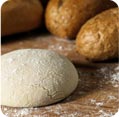Happy New Year!
A Message from Peggy
 Hope your holidays were great. I always look forward to January each year. I get a sense of renewal, a sense of starting afresh and it’s exciting. I’ve never been much of a new year’s resolution person, but ringing in the new year means that Spring is just around the corner and the hectic holidays and year end activities are finally over and I can get down to making new plans and enjoying the new year. Hope your holidays were great. I always look forward to January each year. I get a sense of renewal, a sense of starting afresh and it’s exciting. I’ve never been much of a new year’s resolution person, but ringing in the new year means that Spring is just around the corner and the hectic holidays and year end activities are finally over and I can get down to making new plans and enjoying the new year.
We’ve received lots of emails about the use of natural yeast as opposed to commercial yeast, so I thought I’d share some research and recipes for making your own natural yeast. Of course, if you are in good health and have no intestinal issues like Candida overload or colitis, then commercial yeast should work just fine for you. I use it from time to time when my bread machine is the only way I’m going to get fresh bread made for the day. Hope you enjoy this information. A great web site to order bread starters for your kitchen is www.culturesforhealth.com. We’d also love to share your favorite bread recipes with all our other bakers. Please send them our way.
Back to top

OUR NEW PRODUCT
Now We Offer Sprouted Wheat, Spelt And Rye BERRIES Ready For Milling At Home!
We’ve received numerous requests for our dried sprouted grains from lots of customers who
have their own grain mills. They are NOW AVAILABLE on our web site. We hope you enjoy milling
at home and are very glad to offer you this new product.

Successful New Sprouting
I experimented with sprouting some new grains in December 2009. We successfully sprouted kamut, brown rice,
and millet. Please let me hear from you if you’d be interested in purchasing these sprouted flours or grains.
It will be important to let us know if you would like to order them, because interest will determine whether
we make them available in the near future.
Back to top

Did you know?
About Natural Yeast
 Natural yeast is
a “wild” yeast compared to the store bought hybrid yeast. Both types of yeasts are a single cell fungus that breaks
down the starches in wheat flour through the process of fermentation to create sugar that gives off carbon dioxide gas that makes
the bread rise. Natural yeast starter has yeast and lactobacilli (similar to the lactobacilli in yogurt or other cultured foods)
in a symbiotic relationship. Natural yeast is
a “wild” yeast compared to the store bought hybrid yeast. Both types of yeasts are a single cell fungus that breaks
down the starches in wheat flour through the process of fermentation to create sugar that gives off carbon dioxide gas that makes
the bread rise. Natural yeast starter has yeast and lactobacilli (similar to the lactobacilli in yogurt or other cultured foods)
in a symbiotic relationship.
A store-bought hybrid yeast is like a corn field. It all grows at the same rate and is harvested at the same time. A natural
yeast starter (the lactobacilli is part of the starter) is like an old growth forest. Imagine trees and other plants of
varying heights that grow at different rates. The lactobacilli create the rich flavor and their presence retards bad molds
from growing in the starter. For this reason, a natural yeast starter is responsive to a wide variety of temperature and
humidity changes and doesn’t need a strict schedule, though with use, you’ll learn that your starter is most powerful (lots of
bubbles and puffy) at a certain point in the fermentation process.
This excerpt was taken from the FAQ’s page at www.cristinaacosta.com. This is a great site for bread recipes, baking with natural yeasts, and useful information on achieving great bread.

Back to top

Interesting Homemade Yeast Recipes
Yeast Starter
- 100g (1 cup) + 50g (1/2 cup) flour
- 100ml (6 tbsp.) oil
- 100ml (6 tbsp.) water
- 10g (2 tsp.) honey
Place the 100g of flour, oil, water, and honey in a bowl. Mix well and knead, adding a little more flour as needed to keep the dough from sticking to your fingers. Let rest at least 2 days near a radiator. Add the remaining 50g of flour and knead again; let rest another 2 days. Your starter is ready to use.
Homemade Yeast
Make a thin batter of flour and lukewarm water. Let it stand in a warm place until it ferments and is full of bubbles. 2 cups
of this liquid yeast is equal to 1 cup of old yeast. Yeast is good when it is foamy and full of beads, has a brisk pungent odor
and has a snap and vim1. It is bad when it has an acid odor, is watery and has a tin film on top.
1. vim: lively or energetic spirit; enthusiasm; vitality.
Recipe From: Reflections Custer County Women’s Club, 1976. These recipes and many others are available
at www.thecookinginn.com
Back to top
|